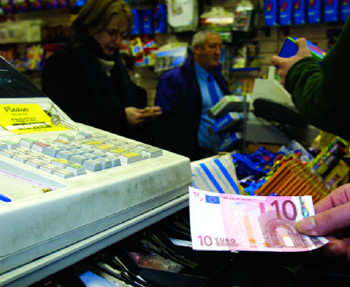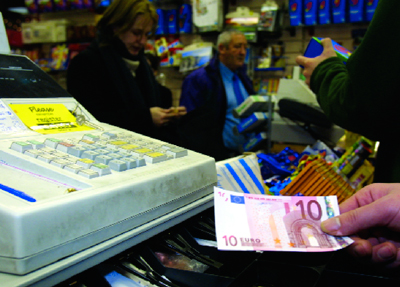To catch a thief

Retail theft impacts on everyone with the consumer ultimately hurt in the form of higher prices. So what systems can you put in place to keep shrinkage and pilfering in check?
1 April 2008
Research has found that there has been an increase in the average cost per theft incident. Crime against business has many consequences; the most significant being higher insurance premiums, increased security costs, poor staff satisfaction and retention (especially where violent crime is frequent) and often alterations to premises.
Retail crime in Ireland can lead to losses of up to five per cent of sales – which is 2.5 times greater than in the UK.
In many cases, theses impacts result in poor job creation, no regeneration for an area and in extreme cases, closure of businesses. Dealing with instances of crime also distracts business owners from running their businesses.

According to the National Retail Security Survey, the number one source of shrinkage for a retail business is internal theft. Some of the types of employee theft include discount abuse, refund abuse and even credit card abuse.
Across the Atlantic the story is no different. According to retail consultant Burt Flickinger III, shrinkage is rapidly increasing and is going to cost Wal-Mart an estimated $3 billion.
The losses are in the form of shoplifting, employee theft, supplier fraud and paperwork errors. Wal-Mart has not officially revealed its shrinkage rate, but analysts suspect that it is rising and coming closer to the industry average.
Look for specific tools
Theft is a big issue in the US retail industry and cost $41.6 billion in 2006, according to a study done by the National Retail Federation and the University of Florida.
The report found that 47 per cent of shrinkage was due to employee theft and 32 per cent due to shoplifting, while paperwork errors occurred 14 per cent of the time and supplier fraud for four per cent.
Neil Matthews Checkpoint VP GM for northern central and eastern Europe, said retailers need to look at specific tools to resolve the different kinds of theft be it from external or internal sources.
“We always talk about a combination of people, processes and technology (PPT). If they all work together then you’ll have a very successful shrinkage strategy.”
Matthews suggests starting with the people side and ensuring all employees understand shrinkage. The employees also need to engage with the technology. So if the premises is using ES tags or CCTV and an alarm goes off they respond to it ,or if someone comes into the store they make eye contact with the person.
Similarly good processes are also vital. “If you go into a well run store everything is organised and in its place and the entire staff comply with these processes.
“The technologies used need to help people engage with the security so they need to be easy to use and manage. The combination of PPT makes a huge difference to shrinkage.”
The hot spots for theft
The till or point of sale is one of the most high risk areas for theft, be it from sweethearting, giving wrong change, returns and voiding. Matthews said Checkpoint is looking at methods to resolve these issues. “We’re working with POS data and using analytical tools that are aligned with CCTV which can connect to the cash desk to try and observe what the cashiers are doing and detect if there’s been a change in behaviour.”
Other precautions shopkeepers must take into account is cameras and security in the backroom, stock areas and possibly on the perimeter doors all of which can be connected to CCTV. Random bag checks on staff can also be employed to help beef up security.
But can too much security make the workplace oppressive? “Yes, it’s a good point. Trends over the last 10 years have leaned towards wider aisles, more inviting stores, relaxed management style and trust of staff. That’s now swinging back the other way in some of those areas because it was having a massive effect on shrinkage. Now some places are making aisles narrower, putting more barriers near the exits. Also the high turnover of staff in retail means most of them are only temporary and have no great loyalty to the store. A soft management style sounds great but it’s very difficult in retail.”
High tech facial detection modes
CCTV is of course one of the most effective ways of combating crime and theft. Eoghan O’Leary, CCTV sales manager for Osmosis said CCTV is becoming one of the most popular requested technologies for retail outlets.
Osmosis’s most popular product in this range is Ozone, a CCTV system that comes with a DVR with 4Tbs of storage.
CCTV has also developed beyond traditional security function and can also be used as a management tool for analysis of trends such as footfall and so on.
O’Leary said the high end CCTV systems such as Ozone have facial detection. Here, the DVR will take a snapshot of that person coming in and deliver it to a database which is important if you need to give it to the gardai.

One of the main products that retailers are reaching for is POS till scan where a camera monitors the till and the cashier. You can observe all the events where no scan went through, so evidence can be searched in that way. It’s a huge deterrent for staff
According to O’Leary one of the main products that retail is reaching out for is POS till scan where a camera monitors the till and the cashier. Overlayed on the video image is all the transaction information. “So you can find out things such as ‘show me all the events where no scan went through’ so footage can be manipulated and searched in that way. It’s a huge deterrent for staff. And it’s an important management tool for shop owners.”
But is the cost of CCTV expensive? “No”, says O’Leary and points out that the cost of high end systems have come down over the past number of years. “As technology advances it’s beneficial to the end users because systems are getting more powerful, user friendly and more readily available from a cost perspective.
“Another huge point with CCTV is that you can hook it up to a broadband connection and put it online. So, you can log on from anywhere in the world and in real time see what’s going on in your business. And that allows huge flexibility in management style.”
Pre-empting and stopping crime
One of the more interesting features O’Leary spoke about was the option of ‘out of hours monitoring’. This, he claims, can often help prevent crime before it happens. If the cameras pick up someone attempting to break in to a premises the remote monitoring station agent will be prompted to issue a warning to the thief that he is being observed and the gardai have been called. “It’s pre-empting and stopping crime before it happens and it’s better than an alarm because you’re getting to them before they break in.”
Violent crime should also not be forgotten about here. There have been a number of high profile attacks on people who run businesses. One of the most infamous incidents was when the publican Charlie Chawke was robbed and shot in broad daylight as he was carrying cash and cheques to the bank.
James Hughes, commercial director of Brinks, the cash-in-transit company said owner/operators of businesses were taking huge risks by manually bringing large amounts of money to their bank. “We offer a full, secure service and offer a fully guaranteed insurance policy that once we take responsibility for your cash within the store and sign a receipt to the customer then the onus and responsibility is 100 per cent on our part.”
Hughes said the safe transport of cash takes away the risk not only to owner/operators but also their staff to which they have a duty of care.
“The main things that would worry small operators are if, God forbid, as they were walking cash to the bank themselves – 1: They would lose the cash and 2: They would be injured … or if it happened to a member of staff who was bringing the cash to the bank and in that case there are moral and legal implications.
“So what we do is we provide a safeguard for the retailer to move cash to the bank which protects him and his staff and his business and provides him with a guarantee that once we take the cash it’s as good as him going to the bank itself.”
Hughes said retailers have to remember that criminals will not evaluate how much money is involved in a robbery. They will take the risk based on the fact it’s cash and it’s for nothing “and there are people out there who will do anything for cash”.
Surprisingly, the cost of using a cash-in-transit operation is not as much as many retailers might fear. “People tend to think it’s only for banks or very large businesses. The cost, however, is relatively low and is comparable with getting a taxi from Dublin city centre to the airport. It’s done on a price per collection. And for the peace of mind it offers it’s well worth it.”
Top four sources of shrinkage
- Employee theft: According to the National Retail Security Survey, the number one source of shrinkage for a retail business is internal theft. Some of the types of employee theft include discount abuse, refund abuse and even credit card abuse.
- Shoplifting: Coming in at a close second is shoplifting. Customer theft occurs through concealment, altering or swapping price tags, or transfer from one container to another.
- Administrative error: Simple pricing mistakes due to markups or markdowns can cost retailers quite a bit.
- Vendor fraud: Retailers report vendor fraud occurs most when outside vendors stock inventory within the store.



 Print
Print





Fans 0
Followers